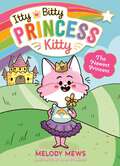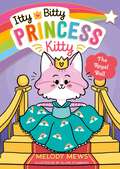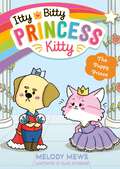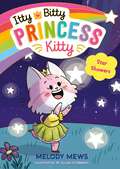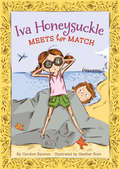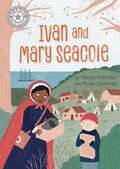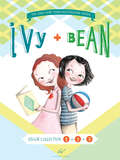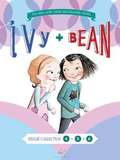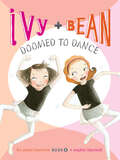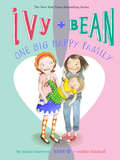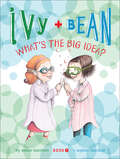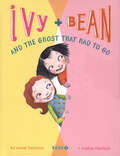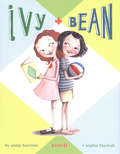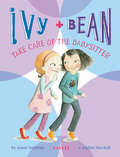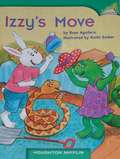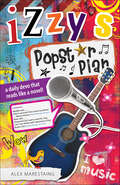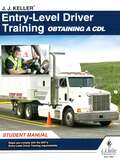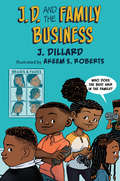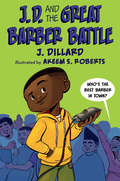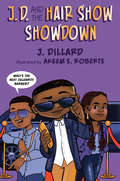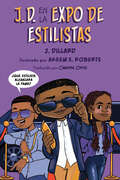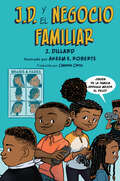- Table View
- List View
Itty Bitty Princess Kitty: The Newest Princess; The Royal Ball; The Puppy Prince; Star Showers (Itty Bitty Princess Kitty #1)
by Melody MewsItty Bitty Kitty is about to become the princess of Lollyland in this first adorable book in the Itty Bitty Princess Kitty chapter book series! Perfect for readers aged 5+ and fans of Isadora Moon, Claude and My Little Pony. Something exciting is happening in Lollyland. Itty Bitty Kitty&’s eighth shooting star is about to arrive and that means she&’s going to become a princess! Itty&’s excited, but when she learns about all the things that are going to change, she&’s also nervous. Between trying out new hairstyles and hearing that she can&’t attend her regular school anymore, Itty begins to feel like she might not be ready to be a princess. Will Itty Bitty Kitty become Itty Bitty Princess Kitty after all? With easy-to-read language and illustrations on every page, the Itty Bitty Princess Kitty chapter books are perfect for emerging readers.
Itty Bitty Princess Kitty: The Newest Princess; The Royal Ball; The Puppy Prince; Star Showers (Itty Bitty Princess Kitty #2)
by Melody MewsItty must learn to dance before her first royal ball in this second adorable book in the Itty Bitty Princess Kitty chapter book series! Perfect for readers aged 5+ and fans of Isadora Moon, Claude and My Little Pony. There&’s going to be a royal ball at the palace! The ball is when Itty will present herself as princess for the first time. Itty also has to teach all of Lollyland a new dance on the spot. There&’s just one problem – Itty has no idea how to dance! Will the princess work something out, or will she dance her way into disaster? With easy-to-read language and illustrations on every page, the Itty Bitty Princess Kitty chapter books are perfect for emerging readers.
Itty Bitty Princess Kitty: The Newest Princess; The Royal Ball; The Puppy Prince; Star Showers (Itty Bitty Princess Kitty #3)
by Melody MewsWill Itty get along with Prince Pip of Wagmire? Find out in this third adorable book in the Itty Bitty Princess Kitty chapter book series! Perfect for readers aged 5+ and fans of Isadora Moon, Claude and My Little Pony. The royal family of Wagmire is visiting Lollyland! Itty is excited to meet the puppy prince, Pip, for the first time. So why doesn&’t Prince Pip seem very excited to meet her? Itty tries to show him all the fun things to do in Lollyland – but he turns his little dog nose up at everything. Can the prince and princess ever become friends, or are cats and dogs just too different? With easy-to-read language and illustrations on every page, the Itty Bitty Princess Kitty chapter books are perfect for emerging readers.
Itty Bitty Princess Kitty: The Newest Princess; The Royal Ball; The Puppy Prince; Star Showers (Itty Bitty Princess Kitty #4)
by Melody MewsCan Itty fix the mixed-up wishes of Lollyland? Find out in this fourth adorable book in the Itty Bitty Princess Kitty chapter book series! Perfect for readers aged 5+ and fans of Isadora Moon, Claude and My Little Pony. A star shower is a once-in-a-lifetime event for the residents of Lollyland! As Itty Bitty Princess Kitty learns, a star shower means that everyone has the chance to wish upon a star and release it back into the sky. Then their wish is granted! But things go very wrong when a huge gust of wind causes all the wishes to get mixed up! Will Itty be able to help fix the problem? And will Lollyland's wishes ever come true? With easy-to-read language and illustrations on every page, the Itty Bitty Princess Kitty chapter books are perfect for emerging readers.
Iva Honeysuckle Meets Her Match (An Iva Honeysuckle Book)
by Candice RansomUncertain, Virginia is no place for an explorer like Iva Honeysuckle to spend the summer. When Iva finds out her family is going on vacation, she's thrilled. She knows she will make her next great discovery at Stingray Point. The very name promises adventure and danger. Iva soon realizes that Stingray Point isn't the exciting place she thought it was. But then Iva hears about the legend of Chessie, the town's very own sea monster. Spotting Chessie would blow all other discoveries out of the water. Stalking a sea monster isn't as easy as it looks. Iva needs a partner--all the best discoverers have one. Iva may have the brains and determination to find Chessie, but she needs someone with a healthy dose of luck. When Iva realizes just who happens to be her perfect match, it will be her greatest discovery of all.
Ivan and Mary Seacole: Independent Reading White 10 (Reading Champion #517)
by Sheryl WebsterThis story is part of Reading Champion, a series carefully linked to book bands to encourage independent reading skills, developed with Dr Sue Bodman and Glen Franklin of UCL Institute of Education (IOE) Fantastic, original stories are accompanied by engaging artwork and a reading activity. Each book has been carefully graded so that it can be matched to a child's reading ability, encouraging reading for pleasure. Perfect for 5-7 year olds or those reading book band white.
Ivy and Bean Bound to Be Bad (Ivy + Bean #5)
by Annie Barrows Sophie BlackallIn the fifth entry in the New York Times–bestselling series, two friends come up with a crazy plan to lure wild animals home.Bean’s day is going downhill, and it’s only nine in the morning. Is it her fault she licked syrup off her plate? Is it her fault Nancy’s yarn got used up? Yes. Bean wonders if being good is worth the effort. Ivy says yes, that if you’re really good, animals will love you and follow you home. Wow! Ivy and Bean decide they’re going to be the best kids in town. They’re going to be kind, they’re going to be generous and pure of heart and—Wait a second! How did they end up muddy, wet, and in trouble?Praise for Bound to Be Bad“Barrows and Blackall deliver another laugh-out-loud Pancake Court romp that derives its humor from the very believable characters and chemistry of the neighborhood children. Any child who’s had to suffer a time-out will relate to this one.” —Kirkus Reviews
Ivy and Bean Bundle Set 1 (Ivy and Bean)
by Annie BarrowsNew York Times best-selling series of books for children — Ivy + BeanMeet Ivy and Bean, two friends who never meant to like each other: This boxed set, Ivy & Bean's Secret Treasure Box (Books 1-3) is a delightful introduction to these spunky characters. It includes the first three books in the Ivy and Bean series, and a secret treasure-hiding box with a cool surprise inside!Author Annie Barrows talks about her award-winning Ivy + Bean series: One of the big problems of being a kid is that your parents often try to make you play with people you don’t really like. My parents were forever trying to get me to like the kids of their friends. These kids were often weird. I didn’t want to play with them. It was a problem.Ivy and Bean are very different: Bean is loud and wild and goofy. She loves to be involved in games and poke her nose in other people’s business. Ivy is quiet and full of ideas. She spends most of her time learning how to be a witch. Each girl thinks the other one is weird. Each girl thinks she could never be friends with the other. But sometimes opposites can become the best of friends because they’re opposites.Ivy & Bean's Secret Treasure Box (Books 1-3) includes:Book 1: Ivy + Bean: Both girls were sure they would never like each other, but when Bean finds herself in a pickle, Ivy helps out with a magical spell. The results are glorious: Bean’s sister Nancy loses her mind, and Ivy and Bean become forever friends.Book 2: Ivy + Bean and the Ghost that Had to Go: Ivy discovers that there’s a ghost in the girl’s bathroom at Emerson School. What could be cooler? Nothing, until the teachers find out, and Ivy gets in trouble. The girls have to get rid of the ghost, and quick. Potions—and plumbing—come to the rescue.Book 3: Ivy + Bean Break the Fossil Record: Bean wants to break a world record, but all she seems to be breaking is dishes. Out in Bean’s backyard, Ivy and Bean dig up a pile of ancient bones and discover that they are record-breakers: they’re the youngest paleontologists in the world! The problem is that nobody believes them.If you and your child liked Junie B. Jones, Magic Tree House books, and Princess in Black; you'll love Ivy & Bean.
Ivy and Bean Bundle Set 2 (Books 4-6)
by Annie Barrows Sophie BlackallThis super-cute bundle continues the adventures of spunky second graders, Ivy and Bean. It includes<P> IVY AND BEAN TAKE CARE OF THE BABYSITTER: What's the worst babysitter you can imagine? Okay, now multiply by a million. Bean's just found out that Nancy is babysitting for the afternoon. After Ivy rescues her from prison, the two girls turn tragedy into opportunity.<P> IVY AND BEAN: BOUND TO BE BAD: Ivy has decided to become good. Extra-super-duperly good. Bean figures that's a big waste of time--until Ivy explains that if you're really good, animals and birds follow you around. Wow! Animals and birds! Bean's going to be good, too! They're going to be nice; they're going to be sweet; they're going to be kind and generous and--Wait a second! How did they end up muddy, wet, and in trouble?<P> IVY AND BEAN: DOOMED TO DANCE: Ooops. Ivy and Bean have made a terrible mistake. They thought that ballet meant leaping, kicking, and cool costumes. Instead, it means they're going to have to be The Two Friendly Squids in a ballet the teacher made up. How embarrassing. As disaster looms, the girls come up with a great escape plan. It's an easy plan, a simple plan, a beautiful plan. It only involves a field trip, a couple of sharks, and some weird animals that glow in the dark.<P> Please note, this book does not have page numbers.
Ivy and Bean Doomed to Dance (Ivy + Bean #6)
by Annie Barrows Sophie BlackallIn the sixth entry in the New York Times–bestselling series, two best friends learn about ballet, promises, and how to be a squid.Finally! After months of begging their parents for ballet lessons, Ivy and Bean finally get what they want . . . well, not exactly. Much to their surprise, it turns out ballet lessons do not cover karate chops and roundhouse kicks. The girls have no interest in learning how to dance gracefully, but they promised their parents they would finish the entire ballet course! When it comes time for Ivy and Bean to participate in the ocean-themed class recital, the girls must figure out a way to get out of it without breaking their promises.Praise for Doomed to Dance“Another pleasing adventure, engagingly illustrated and fun for new readers.” —Booklist “The story is solidly written, and the expressive black-and-white illustrations, some full page, add to the humor. Early chapter-book readers will appreciate and relate to the friends’ dilemma.” —School Library Journal
Ivy and Bean One Big Happy Family: Book 11 (Ivy and Bean #11)
by Annie BarrowsAnnie Barrows' bestselling chapter book series, Ivy & Bean, is a classroom favorite and has been keeping kids laughing–—and reading—for more than a decade! With more than 5 million copies in print, Ivy & Bean return with a brand-new book for a new generation!Ivy & Bean are back . . . and they are funnier than ever!Ivy's worried. She's read a lot of books about only children, so she knows that they are sometimes spoiled rotten. They don't share their toys. They never do any work. They scream and cry when they don't get their way. Spoiler alert! Ivy doesn't have any brothers or sisters. That's why she's worried. How can she keep from getting spoiled? She could give away all her clothes, but she'd probably get in trouble. She could give away all her toys, but she likes her toys. There's really only one solution: she needs a baby sister, on the double! Luckily, Ivy and Bean know just where to get one.
Ivy and Bean What's the Big Idea? (Ivy + Bean #7)
by Annie Barrows Sophie BlackallIn this seventh entry in the New York Times–bestselling series, two unlikely best friends get creative as they prepare for the Science Fair.It’s the Science Fair, and the second grade is all over it! Some kids are making man-eating robots. Some kids are holding their breath for a very, very long time. Some kids are doing interesting things with vacuum cleaners. The theme, obviously, is global warming. But what should Ivy and Bean do? Something involving explosions? Or ropes? Something with ice cubes? Or maybe . . . maybe something different.Praise for What’s the Big Idea?“This seventh episode about unlikely best friends Ivy and Bean may be the most ambitious and triumphant yet . . . . Barrows and Blackall know just how to expose situations that are familiar to second-graders—with empathy and a light touch.” —Shelf-Awareness
Ivy and Bean and the Ghost That Had to Go: Book 2 (Ivy and Bean)
by Annie BarrowsBest friends Ivy and Bean are back and looking for adventure in the second installment of this engaging new series. This time they've made an amazing discovery—a ghost in the school bathroom! Ivy and Bean can see its cloudy form and its glowing eyes. They can hear its moaning voice. This is the best thing that ever happened at school—until the teachers find out. Now Ivy and Bean have to figure out how to get the ghost out of the bathroom. Will they succeed? Maybe. Will they have fun? Of course!Includes bonus material!- Sneak peek chapter from the next book in the Ivy + Bean series Ivy and Bean Break the Fossil Record by Annie Barrows, illustrated by Sophie Blackall
Ivy and Bean: Book 1 (Ivy and Bean #1)
by Annie BarrowsThe moment they saw each other, Bean and Ivy knew they wouldn't be friends. But when Bean plays a joke on her sister, Nancy, and has to hide, quick! Ivy comes to the rescue, proving that sometimes the best of friends are people never meant to like each other. Vibrant characters and lots of humor make this a charming - and addictive - introduction to a new series.Includes bonus material!- Sneak peek chapter from the next book in the Ivy + Bean series Ivy and Bean and the Ghost That Had to Go by Annie Barrows, illustrated by Sophie Blackall
Ivy and Bean: Book 4 (Ivy and Bean #4)
by Annie Barrows Sophie BlackallThe moment they saw each other, Bean and Ivy knew they wouldn't be friends. But when Bean plays a joke on her sister, Nancy, and has to hide, quick! Ivy comes to the rescue, proving that sometimes the best of friends are people never meant to like each other. Vibrant characters and lots of humor make this a charming - and addictive - introduction to a new series.
Izzy's Move: Grade 1, Level 3 (Houghton Mifflin Leveled Books #14)
by Kathi Ember Rose AguileraNIMAC-sourced textbook <P><P>This is Grade 1, Level 3, Book 14 in the Houghton Mifflin Leveled Books series. The book info is as follows: Level: D / DRA: 4 / Genre: Fantasy / Strategy: Infer/Predict / Skill: Conclusions / Word Count: 129
Izzy's Popstar Plan
by Alex MarestaingIzzy Baxter has big plans—popstar plans. Ever since she was six, she’s dreamed of becoming the world’s next singing sensation. Now sixteen, her singing career is on the rise, and she’s been selected to compete on the hit TV show International Popstar Challenge. As Izzy performs in far off locations such as Tokyo and Paris, it seems as if her plans are coming off without a hitch. But God has plans of His own, and Izzy will soon discover that living for Him is “way cooler” than megastar fame.Presented like a daily blog, set up like a devotional, and read like a novel—this book will be an instant hit with tween girls. This cutting edge new product will meet girls where they are, and girls will love following Izzy on her incredible adventure. Plus, they’ll get daily spiritual food to equip them on their own incredible adventure with God.
J. J. Keller® Entry-Level Driver Training Obtaining a CDL Student Manual
by J. J. Keller & Associates Inc. ®Helps you comply with the DOT'S Entry-Level Driver Training requirements
J.D. and the Family Business (J.D. the Kid Barber #2)
by J. DillardEight-year-old kid barber J.D. joins forces with his sister, who has beauty shop dreams, in this hilarious illustrated chapter book series.J.D. is a barber battle champion. He's graduated from home haircuts to having a regular chair at the neighborhood shop, Hart and Son, and he's making enough money to keep his candy jar stocked and his comic book collection growing. And yet, J.D. knows it's time for his next challenge. He doesn't just want to be the best barber in Meridian, Mississippi—he wants to be the best barber in the state . . . and maybe the country! When his older sister, Vanessa, starts to gain a following online for her hair tutorials, the kids decide that to truly level up, they must join forces. How do two siblings with big personalities, big ambitions, and competitive spirits work together (or not) to take over the hair world?Check out the other chapter books in the J.D. the Kid Barber series:J.D. and the Great Barber BattleJ.D. and the Hair Show Showdown
J.D. and the Great Barber Battle (J.D. the Kid Barber #1)
by J. DillardEight-year-old J.D. turns a tragic home haircut into a thriving barber business in this hilarious new illustrated chapter book seriesJ.D. has a big problem--it's the night before the start of third grade and his mom has just given him his first and worst home haircut. When the steady stream of insults from the entire student body of Douglass Elementary becomes too much for J.D., he takes matters into his own hands and discovers that, unlike his mom, he's a genius with the clippers. His work makes him the talk of the town and brings him enough hair business to open a barbershop from his bedroom. But when Henry Jr., the owner of the only official local barbershop, realizes he's losing clients to J.D., he tries to shut him down for good. How do you find out who's the best barber in all of Meridian, Mississippi? With a GREAT BARBER BATTLE!From the hilarious and creative mind of J. Dillard, an entrepreneur, public speaker, and personal barber, comes a new chapter book series with characters that are easy to fall for and nearly impossible to forget. Akeem S. Roberts' lively illustrations make this series a must-buy for reluctant readers.
J.D. and the Hair Show Showdown (J.D. the Kid Barber #3)
by J. DillardEight-year-old kid barber J.D. takes his talent to an Atlanta hair show in this illustrated chapter-book series.At only eight years old, J.D. the Kid Barber has already won a barber battle and appeared on local TV. Now he&’s the youngest barber to be invited to the Beauty Brothers Hair Expo in Atlanta! J.D. gets the VIP treatment—he takes his first flight, rides in a limo for the first time, and gets gifts from the show&’s sponsors. At the show, there are hair classes to take, product samples to try, and some of J.D.&’s favorite hair influencers to meet. And, of course, there&’s his own demo alongside kid hairstylist, Isabel Is Incredible. But what J.D. is most excited about is snapping a pic with eleven-year-old rap sensation Li&’l Eazy Breezy, which is harder than it sounds! The world of hair and beauty is so much bigger than J.D. could&’ve imagined, and he&’s ready to step up his game. Check out the other chapter books in the J.D. the Kid Barber series:J.D. and the Great Barber Battle J.D. and the Family Business
J.D. en la expo de estilistas (J.D. el niño barbero)
by J. DillardJ.D. —el niño barbero de ocho años— lleva su talento a una expo de estilistas en Atlanta en el tercer libro de esta serie para niños, ahora disponible en español.¡J.D. el niño barbero es el barbero más joven invitado a participar en la Expo de estilistas Beauty Brothers en Atlanta! J.D. recibe tratamiento VIP: viaja por primera vez en avión, lo transportan en limusina y recibe regalos de los patrocinadores. En la expo hay clases para tomar, muestras de productos para probar y están presentes algunos de los influencers de la industria del pelo favoritos de J.D.. Pero lo que más emociona a J.D. es tomarse una foto con Li&’l Eazy Breezy, la sensación del rap de once años, ¡y esto es más difícil de lo que parece! El mundo de la barbería y de la belleza es mucho más grande de lo que J.D. había imaginado, y él está listo para llegar al siguiente nivel. Explora los otros libros en español de la serie J.D. el niño barbero:J.D. y la gran batalla de barberosJ.D. y el negocio familiar Eight-year-old kid barber J.D. takes his talent to an Atlanta hair show in this third book in the J.D. the Kid Barber series. At only eight years old, J.D. the Kid Barber is the youngest barber to be invited to the Beauty Brothers Hair Expo in Atlanta! J.D. gets the VIP treatment—he takes his first flight, rides in a limo for the first time, and gets gifts from the show&’s sponsors. At the show, there are hair classes to take, product samples to try, and some of J.D.&’s favorite hair influencers to meet. But what J.D. is most excited about is snapping a pic with eleven-year-old rap sensation Li&’l Eazy Breezy, which is harder than it sounds! The world of hair and beauty is so much bigger than J.D. could&’ve imagined, and he&’s ready to step up his game. Check out the other chapter books in the J.D. the Kid Barber series: J.D. and the Great Barber BattleJ.D. and the Family Business
J.D. y el negocio familiar (J.D. el niño barbero #2)
by J. DillardJ.D. —el niño barbero de ocho años— une fuerzas con su hermana, que sueña con un salón de belleza en esta divertidísima serie de libros. J.D. tiene ocho años y es el campeón de una batalla de barberos. Ya dejó de cortar pelo en su casa y ahora tiene una silla en la barbería del vecindario, Hart and Son, donde corta pelo regularmente. Está ganando suficiente dinero para mantener surtido su frasco de caramelos y para que siga creciendo su colección de cómics. Sin embargo, J.D. sabe que es momento para su próximo reto. Él no quiere ser solamente el mejor barbero en Meridian, Mississippi, quiere ser el mejor barbero del estado... ¡y quizás hasta del país! Cuando su hermana mayor, Vanessa, comienza a ganar seguidores en el Internet para sus tutoriales de pelo, los hermanos deciden unir fuerzas para realmente llegar al siguiente nivel. ¿Cómo pueden dos hermanos con grandes personalidades, grandes ambiciones y espíritus competitivos trabajar juntos (o no) para tomar las riendas en el mundo del pelo? Explora los otros libros en la serie J.D. el niño barbero J.D. y la gran batalla de barberos
